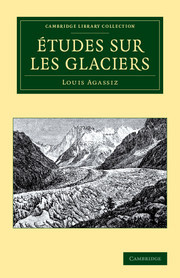Description
Études sur les glaciers
Cambridge Library Collection - Earth Science Series
Author: Agassiz Louis
The revolutionary glacial theory, proposed in this work of 1840, contributed to the demise of the myth of the great biblical flood.
Language: English
Subject for Études sur les glaciers:
Approximative price 35.47 €
In Print (Delivery period: 14 days).
Add to cart
Publication date: 07-2012
Support: Print on demand
Support: Print on demand
Description
/li>Contents
/li>
Swiss-born zoologist, geologist and paleontologist Louis Agassiz (1807?73) was among the foremost scientists of his day. When he took up the study of glaciology and glacial geomorphology in Switzerland in 1836, he recorded evidence left by former glaciers, such as glacial erratics, drumlins and rock scouring and scratching. In this work, published in 1840, he proposed a revolutionary ice-age theory, according to which, glaciers are the remaining portions of sheets of ice which once covered the earth. His radical suggestion undermined the hypothesis that landscape features were the result of a great biblical flood. Although Agassiz's invaluable work led some to acclaim him as the 'father' of glacial theory, critics have cited the contributions of others, including Jean de Charpentier and Karl Schimper. The book also describes the features of active glaciers, including ice tables, ice pinnacles and moraines.
Preface; 1. Aperçu historique sur l'étude des glaciers; 2. Des glaciers en général; 3. De la surface des glaciers; 4. De l'aspect extérieur des glaciers; 5. De la couleur des glaciers; 6. Des crevasses des glaciers; 7. Des aiguilles de glace; 8. Des moraines; 9. Des tables des glaciers; 10. Des cones graveleux des glaciers; 11. De la formation des glaciers; 12. Du mouvement des glaciers; 13. De la surface inférieure des glaciers et des cavités; 14. De l'action des glaciers sur leur fond; 15. De la température des glaciers et des eaux du sol; 16. Des oscillations des glaciers dans les temps historiques; 17. De l'ancienne extension des glaciers dans les Alpes; 18. Preuves de l'existance de grandes nappes de glace en dehors de l'enceinte des Alpes.
© 2024 LAVOISIER S.A.S.
These books may interest you

Colour Atlas of Glacial Phenomena 214.69 €

Dynamics of Ice Sheets and Glaciers 210.99 €


